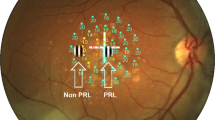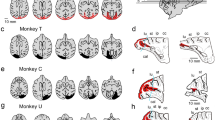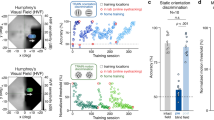Abstract
THE human retina projects not only to the lateral geniculate bodies and from there to the visual cortices, but in a parallel fashion to several other subcortical centres as well. One such centre is the superior colliculus, and it has been suggested that a rudimentary discrimination capacity of the locus of visual stimuli may be mediated by this structure1. Results of anatomical studies with subhuman primates indicate that the macular region does not project to the superior colliculus2,3 (or that it is represented by a different population of retinal fibres which have not yet been identified by anatomical techniques4). The macular region seems to project only to the lateral geniculate bodies and from there to visual cortices, whereas the retinal periphery projects to several subcortical centres. This raises the question of whether a similar dissociation of projection between the central and peripheral retina also can be found in the human visual system. We present data obtained from patients with lesions of the central visual pathways which indeed suggest such a dissociation.
This is a preview of subscription content, access via your institution
Access options
Subscribe to this journal
Receive 51 print issues and online access
$199.00 per year
only $3.90 per issue
Buy this article
- Purchase on Springer Link
- Instant access to full article PDF
Prices may be subject to local taxes which are calculated during checkout
Similar content being viewed by others
Change history
01 September 1975
In the article "Eccentricity-specific dissociation of visual functions in patients with lesions of the central visual pathways" by E. Poppel et al. (Nature, 256, 489; 1975) Fig. 1 and its legend should have been deleted and do not refer to the paper as published.
References
Pöppel, E., Held, R., and Frost, D., Nature, 243, 295 (1973).
Brouwer, B., and Zeeman, W. P. C., Brain, 49, 1 (1926).
Wilson, M. E., and Toyne, M. J., Brain Res., 24, 395 (1970).
Schiller, P. H., Stryker, M., Cynader, M., and Berman, N., J. Neurophysiol., 37, 181 (1974).
Sloan, L. L., Archs Ophthalmol., 86, 612 (1971).
Hylkema, B. S., v. Graefes Arch. Ophthalmol., 146, 110 (1944).
Teuber, H.-L., Battersby, W. S., and Bender, M. B., Visual Field Defects after Penetrating Missile Wounds of the Brain (Harvard University Press, Cambridge, Massachusetts, 1960).
Goldman, P. S., Lodge, A., Hammer, L. R., Semmes, J., and Mishkin, M., Neuropsychol., 6, 355 (1968).
Koerner, F., and Teuber, H.-L., Expl Brain Res., 18, 88 (1973).
Brown, J. L., in Vision and Visual Perception (edit. by Graham, C. H.), 251 (Wiley, New York, 1965).
Frost, D., and Pöppel, E., Pflügers Arch. (Eur. J. Physiol.), R64 (1974).
Author information
Authors and Affiliations
Rights and permissions
About this article
Cite this article
PÖPPEL, E., VON CRAMON, D. & BACKMUND, H. Eccentricity-specific dissociation of visual functions in patients with lesions of the central visual pathways. Nature 256, 489–490 (1975). https://doi.org/10.1038/256489a0
Received:
Accepted:
Published:
Issue Date:
DOI: https://doi.org/10.1038/256489a0
This article is cited by
-
The visual field paradox: a theoretical account on the reafference principle providing a common frame for the homogeneity and inhomogeneity of visual representation
Cognitive Processing (2012)
-
Spatial orienting in the visual field: a unified perceptual space?
Cognitive Processing (2012)
-
fMRI correlates of inhibition of return in perifoveal and peripheral visual field
Cognitive Processing (2012)
-
Two spatially separated attention systems in the visual field: evidence from inhibition of return
Cognitive Processing (2007)
-
Eccentricity-dependent residual target detection in visual field defects
Experimental Brain Research (1986)
Comments
By submitting a comment you agree to abide by our Terms and Community Guidelines. If you find something abusive or that does not comply with our terms or guidelines please flag it as inappropriate.



